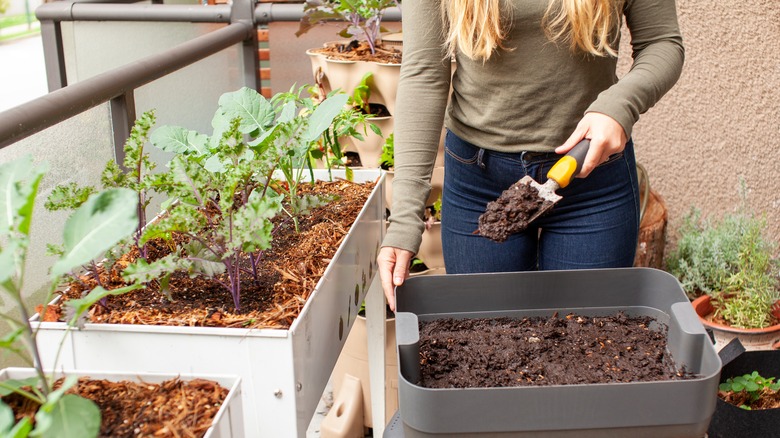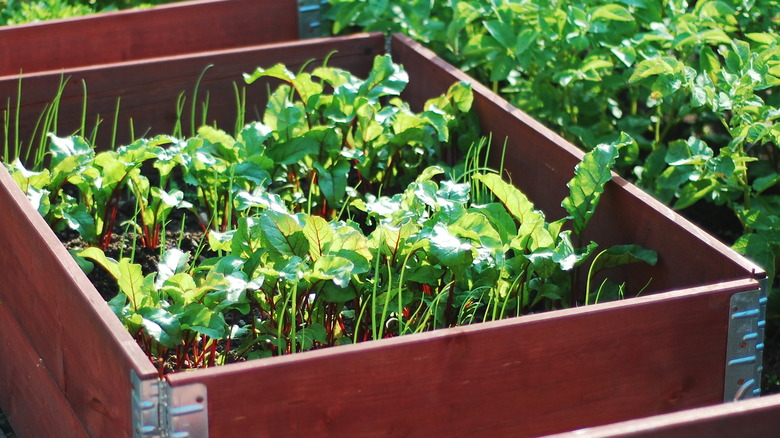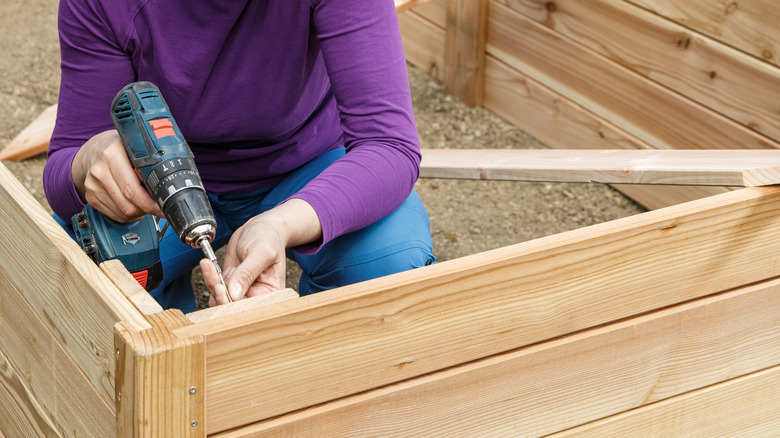Here's The Ideal Size For A Raised Garden Bed
A raised garden bed is an accessible way to become a home gardener, whether you're a city dweller lacking soil, a plant caretaker with little space to grow, a big backyarder who's tired of tending, or a person who needs those plants just a bit closer. Raised beds are smaller (typically just a few feet wide), require less maintenance, and you can work next to them rather than down in the dirt the way you would in a traditional garden.
Plus, if you're a vegetable grower, you can actually increase your yield with this setup: According to the University of Florida's Institute of Food and Agricultural Sciences (UF/IFAS), vegetables in a raised garden can be planted closer together than in-ground vegetables, allowing you to get more use out of the same amount of space. UF/IFAS additionally points out that raised beds better deter the pests that can negatively affect your crop — while also allowing you to control and improve your soil conditions. The benefits of a raised garden bed are clearly there, but how exactly do you go about building one? And before you get started, how big does it need to be?
Measuring matters, especially for width and depth
"Measure twice, cut once" is a common expression for a reason. When designing a raised garden bed, width, length, and depth are all important considerations, as is spacing if you're planning to have more than one raised bed in your yard. The University of Georgia Cooperative Extension (UGA Extension) advises that the width of your raised bed depends on how far you can comfortably reach. A typical width is right around 4 feet, but if a child or a person with decreased mobility will be working in the bed, you may need to reduce the width to 2 or 3 feet. The length of your raised bed, meanwhile, is really a matter of personal preference based on material availability and the size of your space.
When it comes to the depth of the bed, the UGA Extension says most crops will do well in 10 inches of soil minimum, but you can go higher depending on what you're planting in your raised garden, how much you want to spend on soil and materials, and how accessible you want the bed to be. The deepest you'll likely go is 24 inches, according to UF/IFAS; if you want the bed higher than that, consider adding legs or mounting the box on blocks or other props. However, to ensure stability when increasing the bed's height with legs or a mount, be sure that the base drains easily but is still firm enough to hold the soil after watering or rain (it will weigh more than when it's dry).
Constructing your raised garden bed with size in mind
Once you have the size of your raised garden bed figured out, it's time to construct it. Your approach may vary for many reasons, including the size you're aiming for. You can always buy pre-made kits online or at a local gardening store; if they don't have the size or configuration you're looking for, though, you can also reuse materials or buy them new to build your bed from scratch. Some of the most popular materials are wood, stone, large containers, and concrete. Each has its own advantages and disadvantages, particularly in price, so the size of your planned bed will likely factor into the materials you choose.
When selecting your material, you also need to consider how the material is treated, as some chemicals can harm your plants. UF/IFAS adds that a material that is safe to use with other plants might cause issues with an edible crop, so consider what you're looking to grow when selecting materials as well. When in doubt, try placing a durable plastic liner over your building material before adding soil to prevent direct contact (making sure to add this liner to your size and cost calculations). And if you're not going for height by using legs or some sort of elevated support, you may want to add a few layers of newspaper or cardboard between the bed and the ground, too. This helps deter weeds and pests and keep your raised crops happy.


